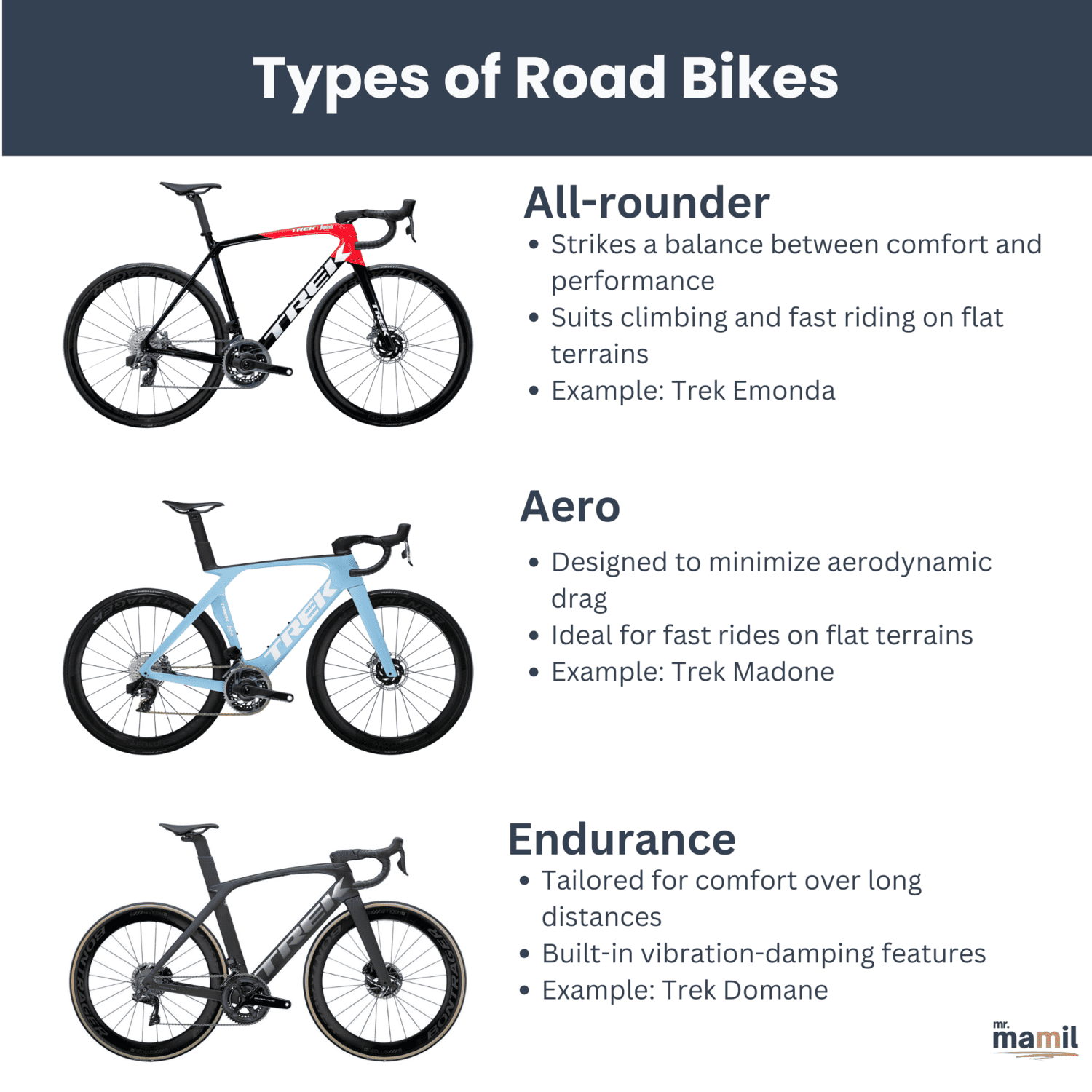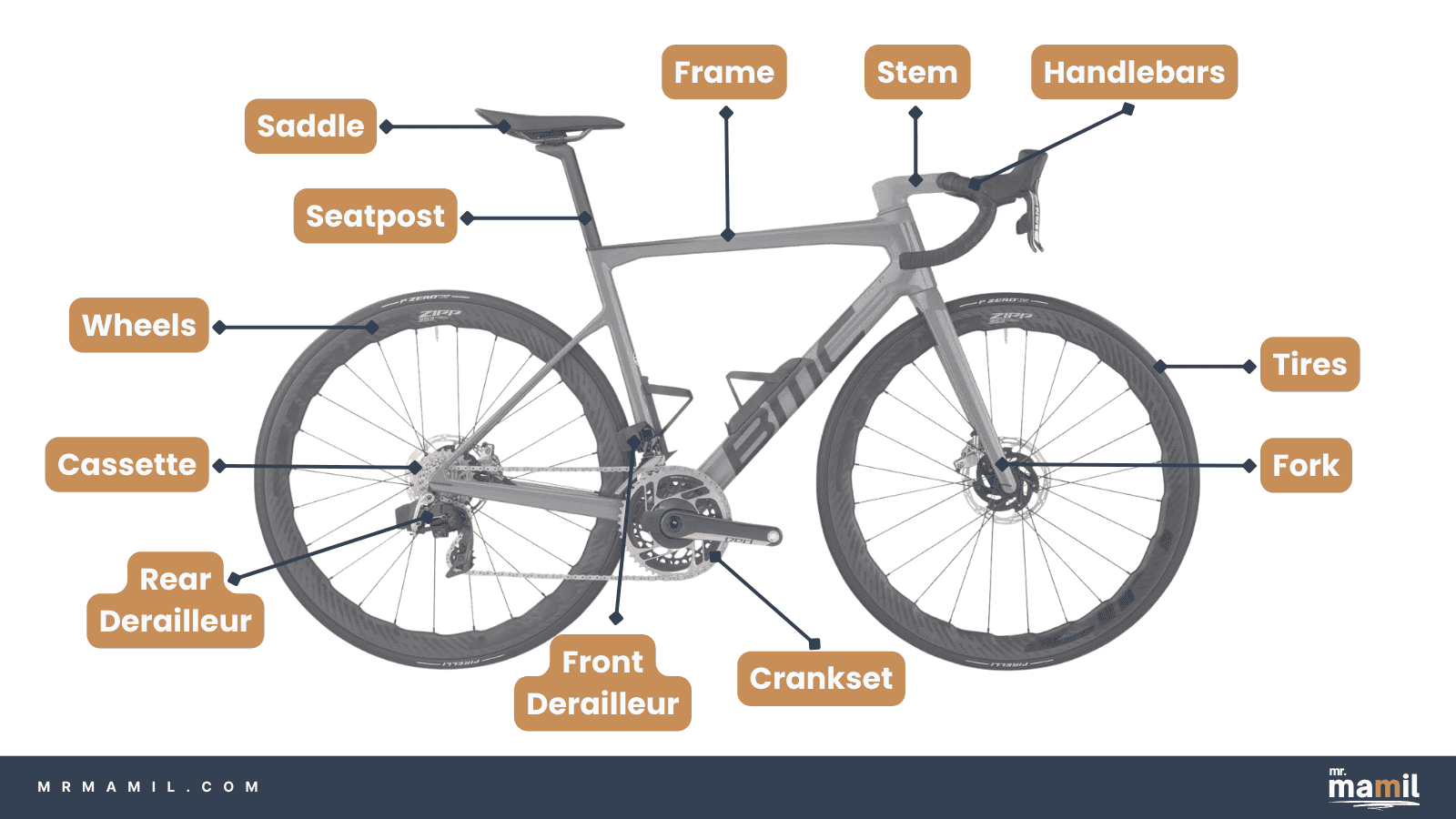Road bike is more than a mode of transportation; it’s a passport to health, a competitive sport, and a way to connect with a vibrant community. Characterized by efficiency and speed, a road bike is specifically designed for the smooth tarmac.
With a road bike, you can experience the exhilaration of racing down a tarmac or the steady joy of long-distance riding with ease.

Road bikes are differentiated by their design and intended use, resulting in distinct characteristics.
- All-rounder road bikes strike a balance between comfort and performance. Their geometry is a compromise, not as aggressive as an aero bike and not as upright as an endurance bike, suitable for both climbing and fast riding on flat terrains. The frame is usually made of carbon fiber or sometimes combines stiffness for efficient power transfer with some compliance for comfort.
- Aero road bikes are designed to minimize aerodynamic drag, making them ideal for fast, flat rides. They have a more aggressive riding position to reduce drag, tend to be heavier, and have aerodynamic features such as deep-section wheels and integrated handlebars, hidden brakes, and cables. They are less comfortable over long distances or on rough terrain, as they tend to be stiffer.
- Endurance road bikes are tailored for comfort over long distances. They offer a more upright riding position to ease the strain on the back and shoulders. These bikes are designed with built-in vibration-damping technologies to absorb road vibrations.
Anatomy of a Road Bike

Each part of a road bike is meticulously designed to fulfill its role without excess weight or inefficiency. The result is a bike capable of fast, long-distance travel on paved roads, with a ride quality and performance that sets it apart from other cycling disciplines.
Let’s take a closer look at each of the main parts.
The frame and fork are fundamental to your road bike. The choice of material significantly affects its weight, stiffness, and ride quality.
- Aluminum is known for being lightweight yet strong. Aluminum frames are responsive and often more cost-effective than other materials. They can be harsh on rough roads, but modern designs often incorporate vibration-absorbing technologies.
- Carbon fiber is prized for its low weight and high stiffness, translating into efficient power transfer when pedaling. Carbon frames can also be engineered to flex in strategic areas for improved comfort.
- Steel is revered for its durability and natural shock-absorbing qualities. While steel offers a smooth ride, it is heavier than aluminum and carbon fiber but can provide a comfortable and resilient bike.
700c is the standard wheel size for road bikes. This translates to approximately 622mm or 29″ diameter. The rim depth can vary, with deeper rims providing aerodynamic advantages at the cost of increased weight and handling issues in crosswinds.
Road bike tires typically range between 23mm to 28mm in width, with some riders opting for slightly wider tires for more comfort without significantly impacting rolling resistance. The trend these days is towards tubeless and wider (28mm or more) tires.
Wider tires increase comfort and provide better grip, which benefits riders on mixed surfaces or those wanting a more stable ride. The tire pressure should be adjusted based on weight, riding style, and conditions.
Higher pressure offers less rolling resistance on smooth pavement, while lower pressure can absorb road bumps better and reduce the risk of punctures.
The drivetrain is at the heart of the road bike. Electronic shifting drivetrain such as Shimano Di2 or SRAM AXS is commonly found in road bikes today with a 12-speed drivetrain, which is made up of,
- Chainrings and cranks. The size of the chainrings affects your bike’s gearing. Larger chainrings are harder to pedal but go faster on flat ground, while smaller chainrings make climbing hills easier. Most road bikes come with two chainrings to provide a wide gearing range.
- Cassette. The number and size of cogs on the cassette allow you to control how hard you need to pedal. There are many cassette sizes available to choose from to cater to different riding terrains.
- Derailleurs. Road bikes come with front and rear derailleurs. They shift the chain from one gear to another.
Brakes are critical for safety, allowing you to control your speed and respond to changing traffic conditions or obstacles.
- Caliper (rim) brakes are traditional in road cycling and are known for their lightweight and aerodynamic profile. However, they can be less effective in wet or very dirty conditions.
- Disc brakes, more common in today’s road bikes, offer improved performance, especially in wet or dirty conditions. They provide consistent braking, don’t wear out the wheel rim, and require less force to activate, which can be less tiring on long descents.
The bike industry is gradually phasing out caliper brakes. Hence, most new, mid to high-end road bikes today are equipped with disc brakes only.
Traditionally, the cockpit is made up of the handlebar and stem. Modern and aero road bikes use a one-piece handlebar, where the stem and handlebars are integrated into one stiff, strong, lightweight component.
Drop bars are quintessential. They offer multiple hand positions for riders to adapt to different riding situations, from upright for comfort to down in the drops for speed.
The handlebar sizes range from 360 to 440mm wide, with various reach and drop combinations. It’s vital that the handlebar’s width, reach, and drop should fit you to avoid strain on the neck and back and to ensure proper breathing.
More reading
Saddles are typically narrow and firm. The majority of road cyclists wear bib shorts with a chamois inside. This increases comfort, minimizes chafing, and is more efficient for pedaling, especially on longer rides.
The saddle’s positioning; its height, tilt, and fore/aft placement are critical to ensure the rider can maintain a powerful and comfortable pedaling motion over extended periods.
Saddle comes in all shapes and sizes. It takes time, effort, and experience to find your ideal saddle. The good news is many leading brands offer demo saddles for testing before you buy.
More reading
Pedals are a crucial contact point between the cyclist and the road bike, acting as the direct channel for power from the rider to the wheels.
Road bikes use clipless pedals. This design allows for a more efficient pedal stroke as it enables the rider to pull up on the pedals and push down, maximizing the power throughout the entire rotation of the pedal stroke.
Clipless pedals come in various designs, some focusing on minimizing weight for performance-oriented riders, while others offer a larger platform to distribute pressure and provide comfort over long rides.
Adjustability is a key feature, with tension settings that can be tweaked to the rider’s preference for easier or more secure clipping in and out.

Alex Lee is the founder and editor-at-large of Mr. Mamil. Coming from a professional engineering background, he breaks down technical cycling nuances into an easy-to-understand and digestible format here.
He has been riding road bikes actively for the past 12 years and started racing competitively in the senior category during the summer recently.